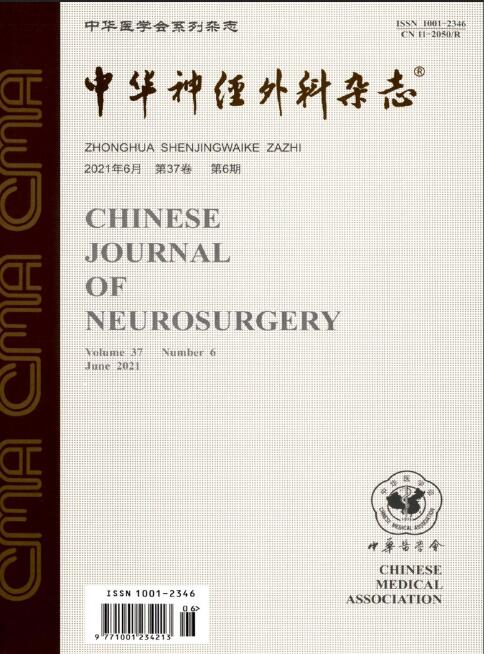术中快速病理诊断幕上肿瘤伴小圆细胞恶性肿瘤的诊治
Q4 Medicine
引用次数: 0
摘要
目的探讨幕上肿瘤术中快速病理诊断为小圆细胞恶性肿瘤的诊断和治疗方法。方法对2011年1月至2017年12月南方医科大学南方医院神经外科36例经术中冷冻病理诊断为小圆细胞恶性肿瘤的幕上肿瘤患者的临床资料进行回顾性分析。所有患者均按照胶质瘤手术的原则进行肿瘤完全切除治疗。术后复查头部MRI,采用体积定量分析确定肿瘤切除程度,分为全切除、次全切除和部分切除。所有患者均在门诊定期随访,并复查MRI以探讨肿瘤复发。结果36例患者术后MRI检查显示31例(86.1%)完全切除,5例(13.9%)次全切除。病理诊断结果:原发性中枢神经系统淋巴瘤(10例)、胶质母细胞瘤(6例)、中枢神经细胞瘤(5例)、原始神经外胚层肿瘤(3例)、脑转移瘤(2例)、松果体细胞瘤(2)、室管膜母细胞瘤,血管周围母细胞瘤1例、嗅觉神经母细胞瘤(1例)和促结缔组织增生性小圆细胞瘤(一例)。术前经MRI诊断的33例患者中,有8例(24.2%)的病理结果与术前诊断相同,其中淋巴瘤4例,中枢神经细胞瘤1例,原始神经外胚层肿瘤1例,血管母细胞瘤和转移瘤各1例。36例患者的随访时间为28.9±8.1个月,从6个月到70个月不等。在随访期间,36名患者中有26名(72.2%)复发。结论幕上肿瘤合并小圆细胞恶性肿瘤在手术中经快速病理诊断,应在安全的前提下最大限度切除,病理结果多样,治疗效果较好。关键词:肿瘤;病理学;治疗结果;运行中;小圆细胞瘤本文章由计算机程序翻译,如有差异,请以英文原文为准。
Diagnosis and treatment of supratentorial tumors with small round cell malignancies diagnosed by intraoperative rapid pathology
Objective
To explore the diagnosis and treatment of supratentorial tumors with small round cell malignancies diagnosed by intraoperative rapid pathology.
Methods
A retrospective analysis was conducted on the clinical data of 36 patients with supratentorial tumors diagnosed as small round cell malignant tumors by intraoperative frozen pathology at Department of Neurosurgery, Nanfang Hospital, Southern Medical University from January 2011 to December 2017. All patients were treated with complete tumor resection according to the principle of glioma operation. After the operation, the MRI of the head was reexamined, and the volume quantitative analysis was used to determine the degree of tumor resection, which was divided into complete resection, subtotal resection and partial resection. All patients were followed up regularly in outpatient department, and MRI was reexamined to explore the recurrence of tumor.
Results
MRI of 36 patients after operation showed that 31 patients (86.1%) had complete resection and 5 patients (13.9%) had subtotal resection. The results of pathological diagnosis were as follows: primary central nervous system lymphoma (10 cases), glioblastoma (6 cases), central neurocytoma (5 cases), primitive neuroectodermal tumors (3 cases), brain metastasis tumor (2 cases), pineal cell tumors(2 cases), ependymoblastoma (2 cases), World Health Organization (WHO) grade Ⅱ glioma (2 cases), pituitary adenoma (1 case), periangioblastoma (1 case), olfactory neuroblastoma(1 case) and desmoplastic small round cell tumor (1 case). Among the 33 patients diagnosed by MRI before operation, 8 (24.2%) had the same pathological results with preoperative diagnosis, including 4 cases of lymphoma, 1 case of central neurocytoma, 1 case of primitive neuroectodermal tumor, 1 case of hemangioblastoma and 1 case of metastasis. The follow-up duration of 36 patients was 28.9±8.1 months and ranged from 6 to 70 months . During the follow-up period, 26 out of 36 patients (72.2%) relapsed.
Conclusions
The supratentorial tumors with small round cell malignant tumor diagnosed by rapid pathology during operation should be resected in the maximal range under the premise of safety, the pathological results are various and its therapeutic effect seems relatively good.
Key words:
Supratentorial tumor; Pathology; Treatment outcome; In operation; Small round cell tumor
求助全文
通过发布文献求助,成功后即可免费获取论文全文。
去求助
来源期刊

中华神经外科杂志
Medicine-Surgery
CiteScore
0.10
自引率
0.00%
发文量
10706
期刊介绍:
Chinese Journal of Neurosurgery is one of the series of journals organized by the Chinese Medical Association under the supervision of the China Association for Science and Technology. The journal is aimed at neurosurgeons and related researchers, and reports on the leading scientific research results and clinical experience in the field of neurosurgery, as well as the basic theoretical research closely related to neurosurgery.Chinese Journal of Neurosurgery has been included in many famous domestic search organizations, such as China Knowledge Resources Database, China Biomedical Journal Citation Database, Chinese Biomedical Journal Literature Database, China Science Citation Database, China Biomedical Literature Database, China Science and Technology Paper Citation Statistical Analysis Database, and China Science and Technology Journal Full Text Database, Wanfang Data Database of Medical Journals, etc.
 求助内容:
求助内容: 应助结果提醒方式:
应助结果提醒方式:


